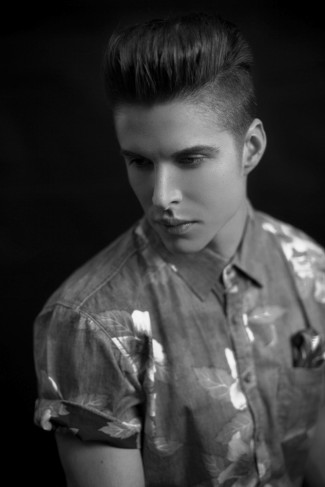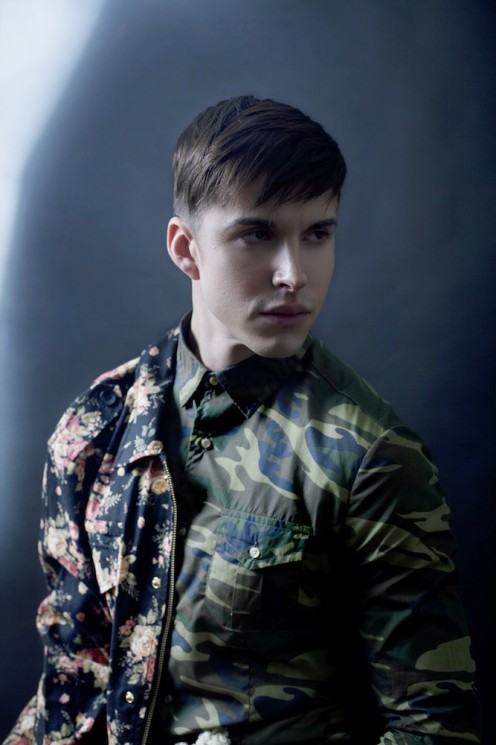
Hair / Nik Nomad
Make Up / Catherine Deschamps
Stylist / Candice Pantin
The Undercut
With last year’s revival of the barbershop, bringing back the romanticism of men’s grooming, guys all over are discovering that having a well-kept vintage coiff is quite an asset to their overall style. Best left in the caring hands of a skilled professional, this heritage trend stems from the Jazz era when rebellion, fads and bold fashion statements ruled.
Popular in multiple variations among most men in the mid-1920s to 1940s, the undercut is a versatile look that leaves the upper layers of your hair long with the sides and back cut short. Whether a clean-cut classic kid or a tattooed cigarette-smoking, grungy-looking badass, this easy-to-maintain cut is enough of a statement to keep well groomed without even trying.



WHAT TO EXPECT:
This haircuts’ short back and sides clear up space around the face showing off facial features and bone structure. It’s a very well-defined and clean cut that complements the shape of the head. Precision is very important when it comes to the structure in this cut making it a solid choice and virtually foolproof. Although there are a lot of styling options, if your barber got it right, this haircut will speak for itself.
It really depends on two things: your hair type and shape of your head. Remember, no two heads are the same, so there are no set rules on how high the fade needs to come up or how long the upper layers have to be.
The fade, a gradual change in length of the hair, and how high it will come up on the sides and back of the head will depend on the shape and proportions of each person’s features; a stylist will be able to judge these factors and cut the hair accordingly. The more hair, whether curly or straight, the bolder the undercut hairstyle.
TRUST THE PROS:
You can’t see all the way around your own head. That’s why visiting a barber or stylist who specializes in short hair is advised rather than taking a clipper to your own mane. Although clippers can be a quick fix, any respectable barber or hairstylist will offer to cut the fade of your undercut with a technique called scissor over comb. This basically means that the hair is being placed in the right position to be cut while the comb moves through the hair. A pro will usually be snipping away twice as fast as he or she is moving the comb upwards from the base of your neck to the top of the fade.
A big part of specializing in short hair is learning how geometrical shapes can complement each other since there are very little lengths in the hair to hide faulty lines. A good stylist will have the right eye to judge these criteria.
The success of this haircut also depends on the sharpness of the outline, so when your hairdresser passes the mirror to the sides and back of your head, double check to see that the line is precisely finished, particularly on the back of your neck and around your ears. Your fade has to be gradual and even all around, without any kinks. If it’s not, ask them to touch it up. And if they don’t give you the final once over with a mirror, don’t go back.


SPEAK UP:
Be clear about the cut you want and styles you like; don’t be afraid to bring in photographs as visual aids. If you’re still unsure, here are a couple of buzzwords that will help you communicate with your barber. You’re going to ask for, “an undercut, a fade and t-zone the top for texture.” What does it all mean?
Undercut – Hairstyle in which the hair on the back and sides of the head are kept much shorter than the hair on the top portion of the head, starting at the crown.
Fade – A gradual change in length of the hair on the sides and back of the head.
“T-Zone the top” – Leaving an untouched section on the top of the head in the shape of a “T”.
STYLING:
Once you have an undercut, try styling the longer top layers of your ‘do with different products in order to be able to explore different textures. Wet and slicked back is nothing like a done/undone tousled look. You can style your hair in different directions using products that will also give you a variety of finishes such as shiny and matte.
For example, work a dime size amount of pomade or paste through dry hair with your fingers in the natural fall of the hair for defined strands in a matte finish. Don’t worry about which direction you are placing the strands and you’ll get the “done-undone” look.
If you’d like to try the classic slicked back look, blow dry your hair away from your face toward the back of your head. When hair is 80% dry, comb gel through your hair in the same direction as you dried it and you’re set!
EXPERIMENT:
The great thing about this style is that the natural oils on your scalp will help hold the shape. So, although you can use product to style it, it’s not necessary. Get experimental when it comes to the texture of the products you’re using to style your hair. The structure of this cut makes it a statement piece in your overall look, allowing to look very put together or effortlessly assembled.
HOW TO MAINTAIN:
If cut properly, your undercut will continue to maintain its structure while growing out, which will save you from the depressing fuzz-ball look other hairstyles tend to deliver two weeks after the original cut. Visit your barber every 4 to 6 weeks to freshen up.
With last year’s revival of the barbershop, bringing back the romanticism of men’s grooming, guys all over are discovering that having a well-kept vintage coiff is quite an asset to their overall style. Best left in the caring hands of a skilled professional, this heritage trend stems from the Jazz era when rebellion, fads and bold fashion statements ruled.
Popular in multiple variations among most men in the mid-1920s to 1940s, the undercut is a versatile look that leaves the upper layers of your hair long with the sides and back cut short. Whether a clean-cut classic kid or a tattooed cigarette-smoking, grungy-looking badass, this easy-to-maintain cut is enough of a statement to keep well groomed without even trying.



WHAT TO EXPECT:
This haircuts’ short back and sides clear up space around the face showing off facial features and bone structure. It’s a very well-defined and clean cut that complements the shape of the head. Precision is very important when it comes to the structure in this cut making it a solid choice and virtually foolproof. Although there are a lot of styling options, if your barber got it right, this haircut will speak for itself.
It really depends on two things: your hair type and shape of your head. Remember, no two heads are the same, so there are no set rules on how high the fade needs to come up or how long the upper layers have to be.
The fade, a gradual change in length of the hair, and how high it will come up on the sides and back of the head will depend on the shape and proportions of each person’s features; a stylist will be able to judge these factors and cut the hair accordingly. The more hair, whether curly or straight, the bolder the undercut hairstyle.
TRUST THE PROS:
You can’t see all the way around your own head. That’s why visiting a barber or stylist who specializes in short hair is advised rather than taking a clipper to your own mane. Although clippers can be a quick fix, any respectable barber or hairstylist will offer to cut the fade of your undercut with a technique called scissor over comb. This basically means that the hair is being placed in the right position to be cut while the comb moves through the hair. A pro will usually be snipping away twice as fast as he or she is moving the comb upwards from the base of your neck to the top of the fade.
A big part of specializing in short hair is learning how geometrical shapes can complement each other since there are very little lengths in the hair to hide faulty lines. A good stylist will have the right eye to judge these criteria.
The success of this haircut also depends on the sharpness of the outline, so when your hairdresser passes the mirror to the sides and back of your head, double check to see that the line is precisely finished, particularly on the back of your neck and around your ears. Your fade has to be gradual and even all around, without any kinks. If it’s not, ask them to touch it up. And if they don’t give you the final once over with a mirror, don’t go back.


SPEAK UP:
Be clear about the cut you want and styles you like; don’t be afraid to bring in photographs as visual aids. If you’re still unsure, here are a couple of buzzwords that will help you communicate with your barber. You’re going to ask for, “an undercut, a fade and t-zone the top for texture.” What does it all mean?
Undercut - Hairstyle in which the hair on the back and sides of the head are kept much shorter than the hair on the top portion of the head, starting at the crown.
Fade - A gradual change in length of the hair on the sides and back of the head.
“T-Zone the top” - Leaving an untouched section on the top of the head in the shape of a “T”.
STYLING:
Once you have an undercut, try styling the longer top layers of your ‘do with different products in order to be able to explore different textures. Wet and slicked back is nothing like a done/undone tousled look. You can style your hair in different directions using products that will also give you a variety of finishes such as shiny and matte.
For example, work a dime size amount of pomade or paste through dry hair with your fingers in the natural fall of the hair for defined strands in a matte finish. Don’t worry about which direction you are placing the strands and you’ll get the “done-undone” look.
If you’d like to try the classic slicked back look, blow dry your hair away from your face toward the back of your head. When hair is 80% dry, comb gel through your hair in the same direction as you dried it and you’re set!
EXPERIMENT:
The great thing about this style is that the natural oils on your scalp will help hold the shape. So, although you can use product to style it, it’s not necessary. Get experimental when it comes to the texture of the products you’re using to style your hair. The structure of this cut makes it a statement piece in your overall look, allowing to look very put together or effortlessly assembled.
HOW TO MAINTAIN:
If cut properly, your undercut will continue to maintain its structure while growing out, which will save you from the depressing fuzz-ball look other hairstyles tend to deliver two weeks after the original cut. Visit your barber every 4 to 6 weeks to freshen up.
Models: Auclair (SPECS Model Management), Simon-Pierre (SPECS Model Management)